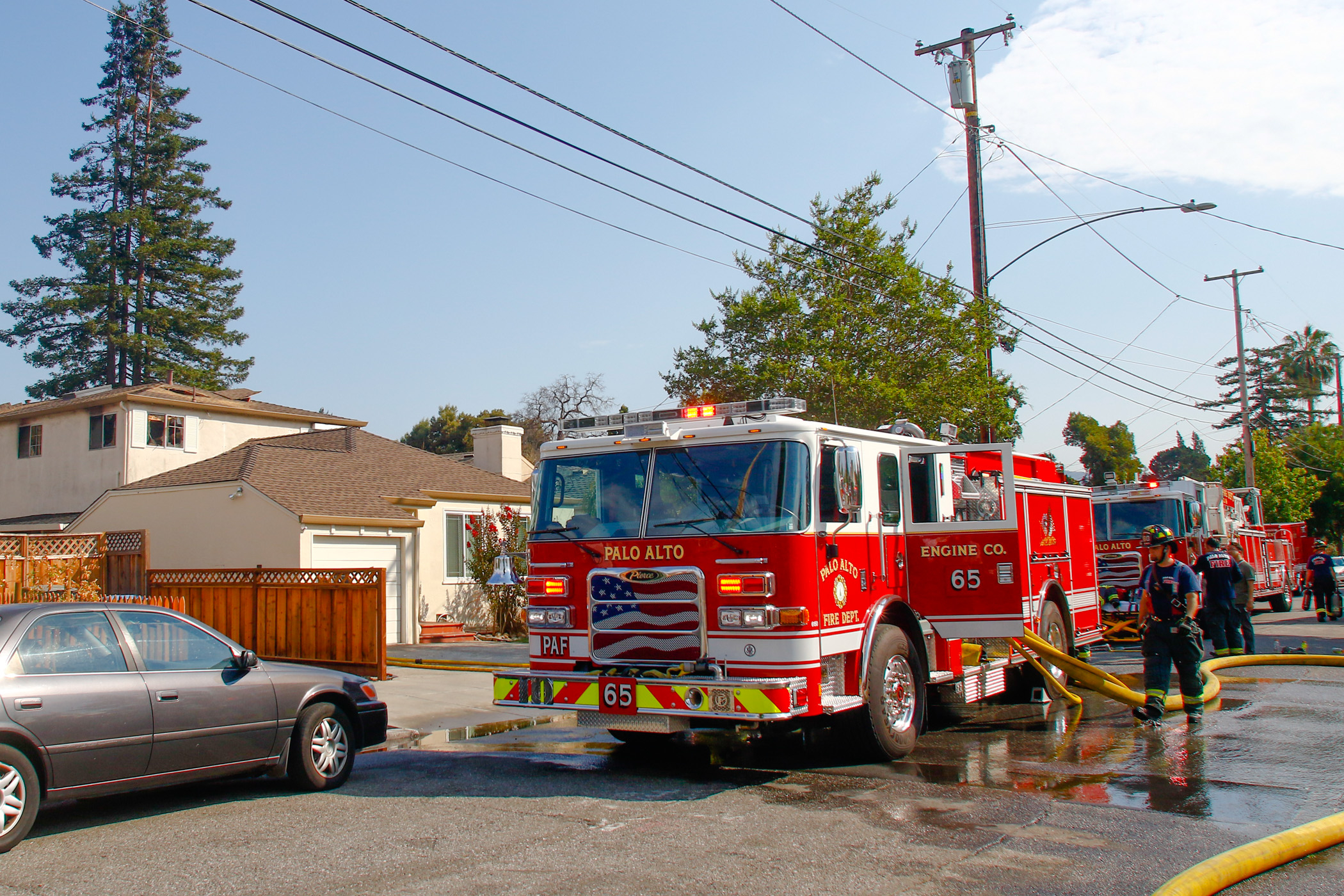Budget cuts and position reductions have taken their toll on the Palo Alto Fire Department, where fewer people are now responding to more medical calls and personnel are increasingly reporting feeling burned out, according to Fire Chief Geo Blackshire.
The city has cut 8.5 full-time-equivalent positions in the department since the start of COVID-19 pandemic, leaving the department with about 90.2 full-time positions. That's a reduction of 31.5 positions from 2012, when the city had 121.7 full-time employees, according to city staff.
The shrinking roster has forced the department to curtail services that it used to provide, including public education to prevent fires and deployment to other parts of the state to help fight wildfires. Last year, the city participated in 14 mutual-aid deployments to battle wildfires, Blackshire told the City Council Finance Committee on Tuesday during its discussion of financial trends. This year, that number went down to zero, Blackshire said.
The downward trend in department staffing began well before the pandemic. Over the past decade, the department has eliminated a "minimum staffing" provision in the firefighters' union contract; pared back its agreement with Stanford University for fire services, which entailed elimination of 11 positions; and adopted a "cross-staffing" model, in which a three-person crew is charged with operating different vehicles. It also reduced the minimum number of employees that must be on duty at any given time and, most recently, approved "brownout" at Station 2 in College Terrace, which is effectively shut down during periods when the department is not fully staffed.
The city had also taken actions that curtailed the firefighters' union to negotiate its staffing levels. In 2010, city voters shot down a measure by the fire union that would have frozen staffing levels in the department. The following year, the council spearheaded a measure that eliminated a provision requiring binding arbitration for contract disputes with public safety unions. That proposal, known as Measure D, was approved by voters and remains in place despite court findings that the city violated state law by failing to negotiate in good faith with employees before placing it on the ballot.
The legal dispute over Measure D continues to drag on, with the court issuing a finding in September that chided the city for its failures to engage with the union but, to the union's chagrin, stopped short of invalidating Measure D.
The recent budget cuts, coupled with the demands of the pandemic and the pressures of perennial wildfire seasons, have made the situation worse, leading to departures and more worker-compensation claims due to injuries and stress. Jonah Peters, secretary for International Association of Firefighters, Local 1319, told the Finance Committee on Tuesday that budget cuts have resulted in "unprecedented levels of mandatory overtime" and have created, for the first time, "a real retention problem."
"The city has chosen to reduce its service to dangerous levels in the name of innovation while ignoring the fallout," Peters said.
This year alone, he noted, four firefighters have left the city for other jobs. More will likely follow suit soon.
"We cannot continue at this pace," he said. "It's unsustainable, and it's causing your employees to leave faster than you can hire them."
Blackshire concurred that with a leaner staff and a growing call volume, more firefighters are feeling "burned out" and injuries have become "almost unavoidable."
"With personnel, eliminating positions means there's been fewer people in suppressing doing the same among of work," Blackshire said, noting that ambulance transports are now almost up to prepandemic levels.
While the committee didn't take any actions on Tuesday, members acknowledged that given the challenges in the department, the council needs to do a better job in both addressing the department's needs and communicating its challenges to the greater community.
Vice Mayor Pat Burt said he was concerned about the fact that staffing levels have been diminished to such a level that the department can no longer provide the services that it used to, including mutual aid to other departments.
"We're going to need that help someday ourselves," Burt said, "We'll get it. But we're not able any longer, at least right now, to do our share of that … And it's fully compensated, we just don't have the staffing."
Chair Alison Cormack suggested that the fire department put together a plan for rebuilding that can be discussed in conjunction with a business tax that the city's plans to bring to the voters in 2022. The plan would include components such as infrastructure, equipment and training.
"That I think would be a package that hopefully will send a message to the people we hope will work for us," Cormack said, "Because it's a small pool. We expect a lot of the people who work for us."
The committee also acknowledged the financial challenges within the department, including the city's swelling pension obligations. According to staff, pension costs have gradually risen over the past decade from $3.6 million in 2012 to $8.5 million in 2021. By 2026, the city's pension obligations are projected to swell to $9.9 million in 2026. Council member Eric Filseth noted that the city's ability to control the pension calls is "not infinite," given that it's based on CalPERS rate of return.
"In many ways, we're paying bills that were run up at the turn of the millennium and they're appearing now," Filseth said.
Fire Department staff noted that compared to other cities, Palo Alto spends far less on firefighting as a proportion of its general fund. According to city staff, 12% of Palo Alto's general fund is devoted to the Fire Department. Redwood City spends 26%, while Mountain View and Santa Clara spend 22% and 21% of their respective general funds on firefighting.
That said, the Fire Department's costs continue to grow faster than revenues, with general fund spending increasing from $15 million to $25 million between 2012 and 2022. The trend has prompted the department to look for new ways to raise revenues. On Monday, the council gave its final approval to the Fire Department's new ambulance subscription service, which will allow residents to pay a monthly fee of $8 and then avoid getting charged for transport services should they need an ambulance. Blackshire said the department is also looking at charging fees for frequent reporters of false alarms.
The committee agreed that despite the budget challenges, the city needs to pay more attention to the impact of recent staffing reductions on the Fire Department's service levels.
"It really is becoming transparent that here and elsewhere in our organization we may have reached past a tipping point where we're at unsustainable staffing levels," Burt said.



Comments
Registered user
Duveneck/St. Francis
on Nov 3, 2021 at 10:48 am
Registered user
on Nov 3, 2021 at 10:48 am
Did the four firefighters go to San Mateo County where they are better paid?
Registered user
Midtown
on Nov 3, 2021 at 11:03 am
Registered user
on Nov 3, 2021 at 11:03 am
My vote would be to stop rewarding the non-working homeless with shelter and free meals and to bring back these fire fighters. [Portion removed.]
Registered user
Crescent Park
on Nov 3, 2021 at 11:56 am
Registered user
on Nov 3, 2021 at 11:56 am
Would not the money being spent on a complete re-do of Rinconada Park have been better spent on restoring a full staff of fire fighters? or the 18 million for Smart Meters? Could these expenditures not been delayed?
Where are our priorities?
Where did the Stimulus money go? thank you
Registered user
Another Palo Alto neighborhood
on Nov 3, 2021 at 5:58 pm
Registered user
on Nov 3, 2021 at 5:58 pm
@ Stepheny: totally agree!
Registered user
Another Palo Alto neighborhood
on Nov 4, 2021 at 12:51 am
Registered user
on Nov 4, 2021 at 12:51 am
I appreciate hearing about this. Safety should come first. Certainly before expensive and reviled (and dubiously contributing to safety) road furniture, for example.
As a resident who values our firefighters, I'm ashamed of the way the City handled Measure D.
It's about time that Palo Alto began buying up properties around town, and became a land landlord the way Stanford is in order to keep the cost of housing down for its faculty and staff. We should be doing that for retail, for public safety (fire and police) and teachers.